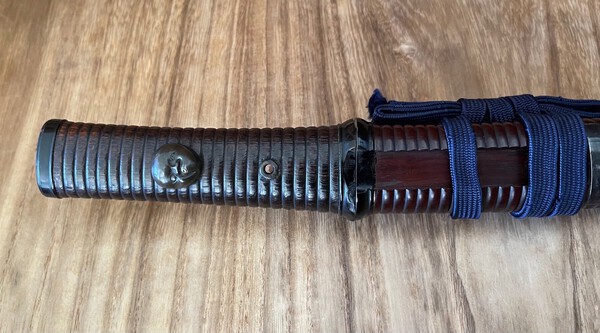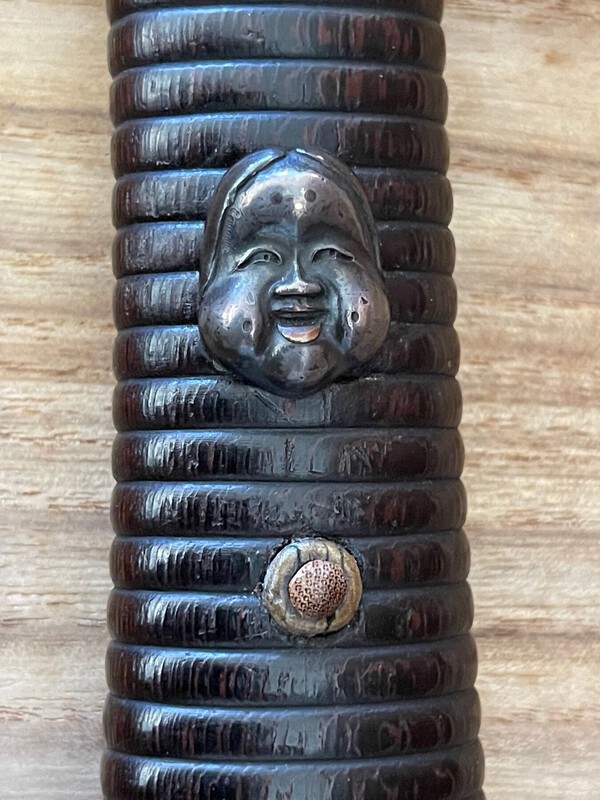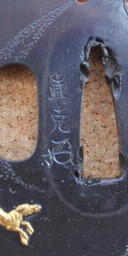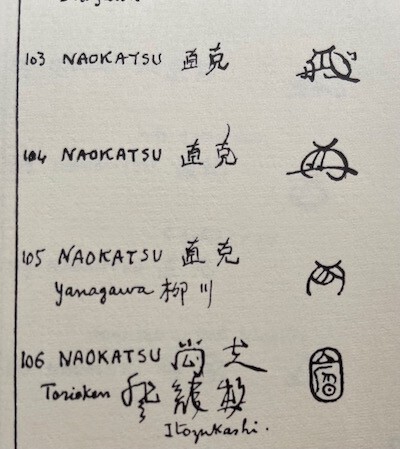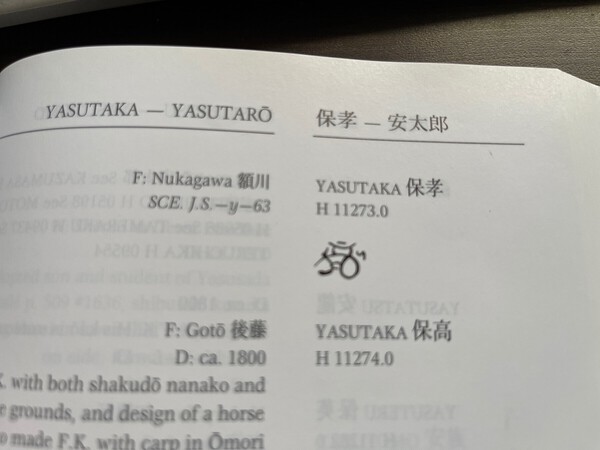-
Posts
286 -
Joined
-
Last visited
-
Days Won
2
Content Type
Profiles
Forums
Events
Store
Downloads
Gallery
Everything posted by Barrie B
-
Hi Micheal, I could not find this in the Kinko Meikan or in Markus' Signatures of Japanese Sword Fitting Artists. Unfortunately I don't have Wakayama's publication. Good luck. Barrie.
-
Curran, that is a very nice Tsuba indeed..! Baz.
-
George (et al), Thanks for sharing your knowledge to broaden mine. And thanks to everyone else for sharing their items to increasing my limited understanding on the use of this theme.. Not as rare as I first thought. I never once imagined this O Tanto/ Ko Wakizashi might have actually been owned by a Bushi, and not by a Kabuki actor.. Thanks again. Baz.
-
Hi, Thanks Dale. I see plenty of Hanya mask themed stuff. Especially Menuki and the odd Tsuba..Cheers for the links as well. Barrie.
-
Hi Dale, LOL.. My interest is because I own this handsome 'Merchant' Koshirae (for lack of a better description) that has similar themed Menuki.. Bit of an unusual theme for a Samurai, I would have thought..? I think it was made very late Edo, when merchants and artists had money? Perhaps I should research the Kozuka artist to put an approximate date to the Kozuka, to support this theory.. I assume it was made for, and owned by a Kabuki artist..? Any other theories? Barrie.
-
HI all, I would like to enquire if a member of our prestigious board happened to win this unusual Kozuka recently? https://page.auctions.yahoo.co.jp/jp/auction/o471217620 Thanks. Barrie.
-
Hi BaZZa, Nice Kozuka; three very nice gold Kamon on a fine Shakudo Nanako ground, presumably made for a formal Koshirae. Haynes does not show this specific Mon, (and I do not have any other references) so yes, I believe a sufficiently different and potentially unrecorded Kamon, which is not surprising. FWIW, they look like Anzu (Apricot Blossom) to me.. Barrie.
-
Hi Bob, At first, I thought the Kakihan (N 104) was a good match and we had found your man, but then I too realised its not quite the same. Pity. That is why I posted them beside each other.. I am not sure if anyone (Haynes for example) found anomalies or or even Gimei contained within Joly's, or maybe there were possibly even minor copying errors ..? Either way, I still reference it from time to time out of curiosity. Anyone have anything more substantial to say about Joly's - as a reference source? Barrie.
-
Hi Gents, Unfortunately I do not have Wakayama's yet, but I have Joly's and have attached a photo of N 104 for you. Barrie.
-
Hi Chuck, Very nice Tsuba. Haynes only has two listed that sign like your man (H 11272.0 & H 11273.0) and the latter has a Kao - that I think resembles yours.. Not exact, but probably to be expected maybe, from a sketch. But then again, most Kao take on a similar form. No much info on either of them, so I doubt anyone would go to the trouble of forging it..? But you never know..! Haynes states the other (H 11272.0) is Hamano Yasutaka and died ca. 1800 - with an unrecorded Kao. Barrie.
-
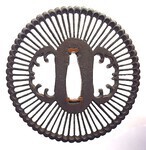
Any how to's for making sword bag's ?
Barrie B replied to Hector_A's topic in General Nihonto Related Discussion
I have made them in the past, but they are a bit of a fiddly thing to make. The Japanese are very clever and if there is a hard way to do something, they will find it. I reverse engineered an old bag and found that it is double lined with a thin layer of padding inside. None of the seams are visible, even when you turn the bag inside out..!.. Basically you have to make the outer and the liner (both inside-out of course to be able to sew them) which are then sewn together on the top of the bag - at what will eventually become the opening of the bag. This is when I also attach the manufactured ring (using the same material) for the fusahiso cord. Then you have to turn one half inside out and then pull the other through it, also turning it inside out so both seams are 'inside' the bag - for want of a better explanation... It is difficult to explain and its a fiddly job. BTW, the liner should be slightly smaller (half inch all round) than the outer so the seams don't bunch or cause creases in the liner later on. Each time I make another bag, I have to sit down and basically re-teach myself the process.. My wife won't touch them..! I used modern materials and sometimes brushed-cotton for the lining of the Koshirae bags, because I could not bring myself to cut up and old Kimono. It is time consuming, but oddly rewarding. I couldn't make them for a living. Of course you can cheat and have the seam showing/ visible inside the bag which is fine, but that is not how they are made. They certainly are worth trying to make though, but study an old bag first. Good luck. Barrie. -
Oh..! I did not realise it was that expensive, The book is written mostly in Japanese, but here are some excellent pics - that I presume show typical Owari Tsuka. BTW Markus Sesko has some koshirae books out explaining the characteristics of Owari koshirae/ tsuka that details the kashira size in comparison to the fuchi size etc. which compliments this book. I can take better photos later, when I have more time - if you need.. Barrie.
-
-
Apologies; I misunderstood the question, but it looks like sikigane (added at the time of manufacture) to me. Barrie.
-
Yas, It is called Sekigane.. An insert (usually copper) to allow the tsuba to fit (snugly) to the nakago.. You don't just see them in the nakago ana either.. They are sometimes fitted in sukashi tsuba around the seppa-dai to fit a koshirae (Koiguchi for example) or in the Ryo hitsu-ana to accomodate kodogu or to protect the kodogu from scratching.. The latter usually being fitted to iron tsuba and done in shakudo or gold to protect the fittings. Here is an example in the kozuka-ana from one of my Akasaka tsuba. Tsuba from Suruga often have kutchibeni style sekigane that are fitted as part of the tsuba aesthetics. This is a kantei point as well. Barrie.
-
🤣🤣 hahaaa... Brilliant. Hi Mal, Never thought of that, but (in my little mind) is plausible.. Barrie.
-
BaZZa, Totally agree. It is an oddity.. One would have thought that a Kamon would be far too important to not be 'on display'.... Obviously the original owner decided comfort (in his hand) when fighting, was more important..? Or he couldn't afford another menuki to be made..! 🤣 Raffaele, So if you only have one menuki and it is only for display (for you), then maybe just place that one menuki on the Ura as you have stated.. As you say, you're not interested in future commercial value. Either way, good luck with your project. Barrie.
-
Hi Raffaele, I have a Daisho and the menuki are mounted in the Yagyu style (or reverse); i.e under the palms of the hand when holding the Tsuka and the Wakizashi only has one menuki fitted. The other menuki is not missing.. This late Edo period Daisho was deliberately designed like this.. Maybe you could emulate that..? Barrie.
-

Samurai history books
Barrie B replied to Robbie Tsunami's topic in General Nihonto Related Discussion
Hi Robert, Try Heavenly Warriors; The evolution of Japans Military, 500 - 1300 by William Wayne Farris. ISBN 0-674-38704-X It's a bit of an 'academic' read, but I found it very interesting. Good luck. Barrie. -
Dick, Wow..! That Kiseru is gorgeous... High quality and definitely a keeper. Well done. Barrie.
-
Markus, I (genuinely) am not concerned with the delay. I love the books and would like to see them in my library as a complete set, in whatever form that takes.. I must say that I am not a fan of having a PDF copy though. I fully understand and appreciate your efforts, in order to assist non Japanese readers in this field. Please do not stop. I too would be willing to pay any 'bridging' cost for better quality printing, if that was where you thought this project needs to go, to see it to completion. Although I paid up front already, it was pittance for what we received (in all fairness), so I feel this additional cost to help, would be worthwhile. I hope others feel the same way as well. Barrie.
-
Hi Markus, I was doing a search in the NMB for Volume three (to see if it had been released yet) and came upon this very old thread from 2018, so please forgive me if this is dead and buried. Looking through my (Vol 2) book, I notice that I have the same/ similar issues with my book in Australia; however, as Guido stated, I am more concerned with the 'English' text, than the high res pictures. Barrie.
-
Ian, Does that book have an english translation? I would love to get a copy of that..! Barrie.
-
Hi Mark, Someone with better knowledge may chime in and provide better insight, but my understanding is that when there are two Kamon placed together, it could be a commissioned gift to acknowledge or celebrate a marriage - as you say, - or maybe a gift to strengthen an alliance between Daimyo, or I have also heard that Samurai families had a 'main' Mon and a 'secondary' Mon.. So the main or dominant Mon would be displayed more prominently on the Omote and the secondary Mon on the Ura. This rule also applies if it was for a union or marriage.. The stronger family's Mon would be more prevalent or conspicuous on the Omote when worn. You often see this with Menuki.. The Omote will have two Mon on the outside and a single Mon in the centre, and that is reversed on the Ura Menuki.. So making the number of Mons 'equal' but at the same time, not displayed that way.. This can also be done by using Gold and Shakudo when displaying Mon. Gold being more visible. I have read somewhere that the free use of Mons got out of hand (unfortunately) by the end of the Edo Period, so trying to chase genealogy or provenance through the use of Mons can sometimes be a waste of time. Barrie.
-
It's probably the reason why we see a lot of Kamon Fuchi without Kashira. The Kashira was not lost; the Fuchi were intended to be fitted with a horn Kashira. Its also why they do not have metal Kojiri as well (on the Katana).. Barrie.





